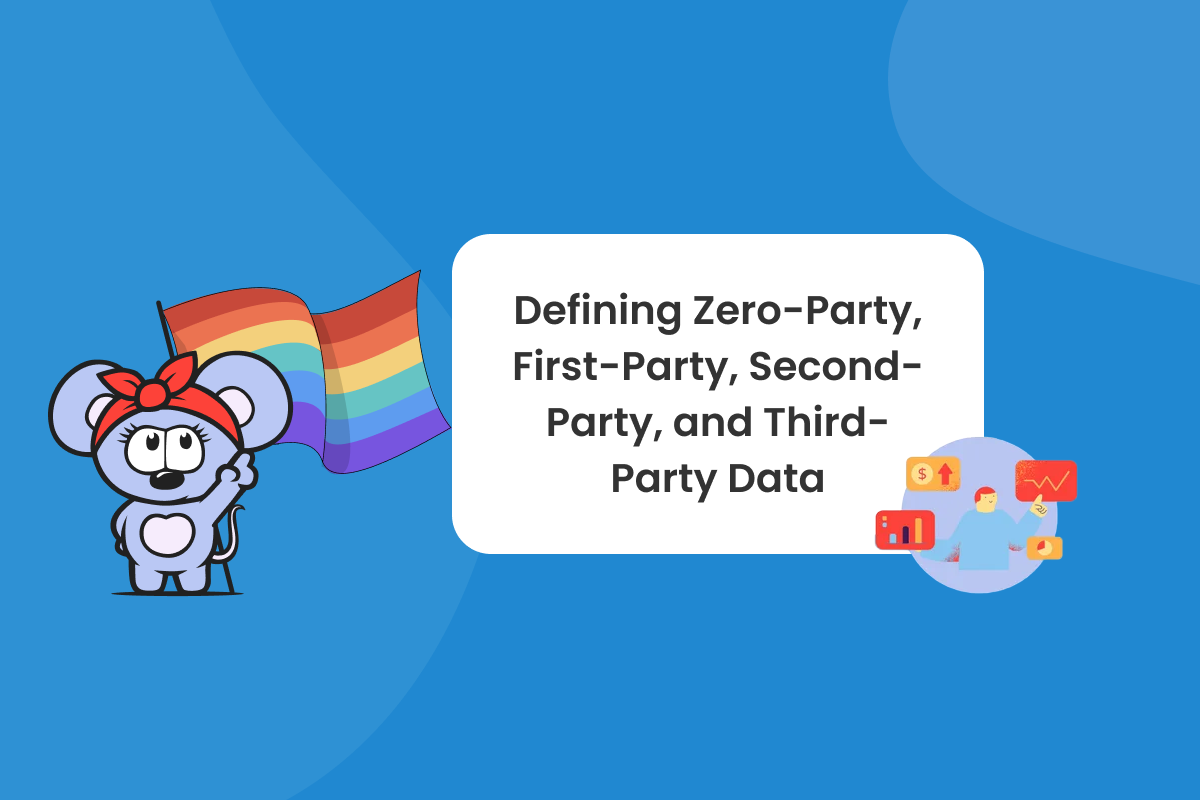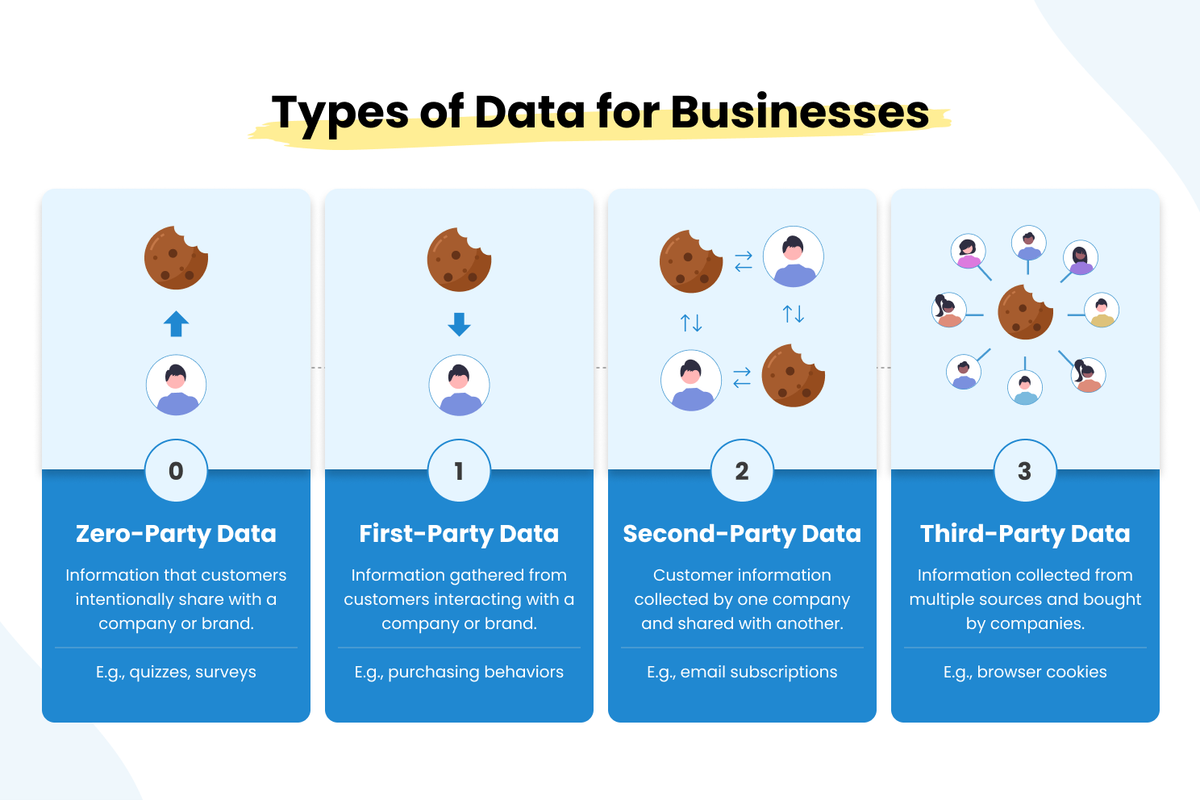
Customer data is essential to understand your audience's pain points, needs, and interests. Relying on customer insights is the foundation of a successful business, and the equivalent of holding a map to a treasure chest — follow the dotted line to victory. There are many variations when it comes to customer data, and in this article we define and explain the differences between data types to help you decide on the best one for your business.
What Is Zero-Party Data?
Zero-party data is when individuals voluntarily share their preferences, interests, and personal information with a business. Unlike other types of data, zero-party data is given intentionally. Companies can use zero-party data to determine what the customer wants from the brand. Brands can collect zero-party data through interactive experiences, surveys, quizzes, or selected user preferences.
Examples of Zero-Party Data Collection
There are many ways businesses can collect zero-party data. Below are some examples of zero-party data collection:
- Online surveys or questionnaires
- Customers providing information about their preferences and demographics
- Quizzes or assessments
- Individuals offering details about their likes and interests
Benefits and Uses of Zero-Party Data
Businesses can build trust and foster a transparent relationship by giving individuals control over their data. Zero-party data offers users a more personalized and tailored experience to receive recommendations, content, and offers that align with their browsing/buying intentions.
Zero-party data helps businesses create targeted marketing campaigns. These campaigns deliver relevant products and content that resonates with their audiences' needs. It eliminates irrelevant information while boosting customer engagement, loyalty, and satisfaction.
What Is First-Party Data?
First-party data is information gathered directly from individuals interacting with a company or brand. This data is typically collected through websites, mobile apps, or offline interactions. First-party data is considered the most valuable data to help businesses better understand their customers. Companies make data-driven decisions about customer behavior, preferences, and purchasing patterns by analyzing first-party data to improve their marketing performance.
Examples of First-Party Data Collection
There are methods businesses can implement to collect first-party data. Some of those methods include:
- Adding tracking pixels to your website or mobile apps
- Collecting information through selective offers, discounts, or exclusive content
- Data collection forms that request name, email addresses, location, occupation, or birthdate
- Customer surveys
Benefits and Uses of First-Party Data
After collecting first-party data, businesses can leverage it for personalized marketing campaigns. Companies can segment their audience and provide content that users want or value based on their browsing/buying behavior. By properly using first-party data, businesses can connect with their customers and deliver messages that encourage repeat business and customer loyalty.
What Is Second-Party Data, and How Does It Differ From First-Party Data?
Second-party data is customer information gathered by one company and shared with another for mutual advantage. Unlike first-party data, collected directly from individuals and their browsing/buying behaviors, second-party data is the same as first-party data, except it is obtained from an outside trusted partner or source. Second-party data allows businesses to reach a larger audience. It is often shared through partnerships, data marketplaces, or purchased from external sources.
Second-party data is helpful for businesses in similar industries that want to expand their data metrics and customer reach. It is a cost-effective way to access more data while managing your resources.
Examples of Second-Party Data Collection
Second-party data is first-party data from an outside source. There are several ways to obtain second-party data, including:
- Business partnerships
- Data management platforms (DMPs)
- Customer data platforms (CDPs)
- Data exchanges
Benefits and Uses of Second-Party Data
Leveraging these platforms allows businesses to aggregate data from multiple sources and create a unified view of their customers.
What Is Third-Party Data?
Third-party data is information gathered from multiple sources not affiliated with a company. This data is typically purchased from providers who collect and sell data. Third-party data helps you gain insights about your audience, including demographics, purchase history, and online behavior.
Examples of Third-Party Data Collection
Like first-party and second-party data, third-party data utilizes surveys, browsing cookies, data forms, and more to collect customer information. Businesses can source third-party data suppliers and purchase this information for a broader customer base. It improves online advertising, ad targeting, market research, and trend analysis for better campaign marketing and relevance.
Drawbacks of Using Third-Party Data
While third-party data offers many benefits, it is essential to consider the potential drawbacks:
- Lack of Data Control: Since external sources collect and manage third-party data, businesses have limited control over its accuracy and reliability.
- Data Privacy Breach: The risk of data breaches or misuse can have severe implications for customer data privacy and security.
- Relevance: Third-party data may not always be as relevant or up to date as first-party or second-party data. Businesses should be careful about the quality and relevance of third-party data before using it in their decision-making processes.
Stay Ahead of Competitors With RebelMouse Data Tools
RebelMouse helps businesses leverage first-party data insights to retain customers and stay competitive. You can access immediate customer insights through our analytics tools for more actionable and relevant targeting. Our data tools are easy to use and comprehend regardless of tech or web analytics experience.
Only ever market with a plan. Let's start collaborating to guarantee your content is supported by data that drives organic growth, engagement, and conversions. To get started, request a demo today.








































































